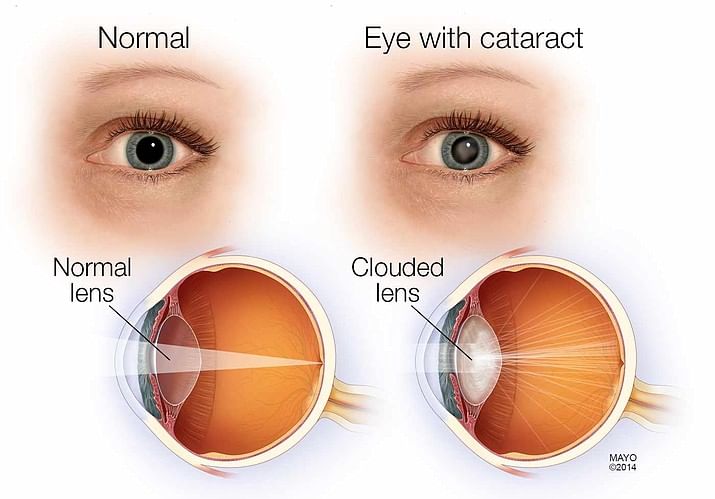Cataract - Homeopathy - Asian Homeocare
Cloudiness of the lens of the eye resulting in decreased vision is referred to as a cataract. A person with cataract experiences glare, foggy and blurred vision and sees halos around lights. A cataract may affect one or both the eyes. It is mostly age-related and is largely seen in the elderly. It can occur due to trauma, post surgery or in rare cases may be present at birth. The person complains of photosensitivity (sensitivity to light) and has difficulty reading, driving and recognizing faces due to diminished vision.
Most cataracts develop slowly and don't disturb your eyesight early on. But with time, cataracts will eventually interfere with your vision.
At first, stronger lighting and eyeglasses can help you deal with cataracts. But if impaired vision interferes with your usual activities, you might need cataract surgery. Fortunately, cataract surgery is generally a safe, effective procedure.
Causes
Most cataracts develop when aging or injury changes the tissue that makes up your eye's lens. Some cataracts are related to inherited genetic disorders that cause other health problems and increase your risk of cataracts. Cataracts can also be caused by other eye conditions, medical conditions such as diabetes, trauma or past eye surgery. Long-term use of steroid medications, too, can cause cataracts to develop.
How a cataract forms
The lens, where cataracts form, is positioned behind the colored part of your eye (iris). The lens focuses light that passes into your eye, producing clear, sharp images on the retina — the light-sensitive membrane on the back inside wall of your eyeball that functions like the film of a camera.
A cataract scatters the light as it passes through the lens, preventing a sharply defined image from reaching your retina. As a result, your vision becomes blurred.
As you age, the lenses in your eyes become less flexible, less transparent and thicker. Age-related changes cause tissues within the lens to break down and clump together, clouding small areas within the lens. As the cataract continues to develop, the clouding becomes denser and involves a greater part of the lens.
Cataracts may develop in only one eye, but they usually develop in both of your eyes. However, cataracts usually aren't totally symmetrical, and the cataract in one eye may be more advanced than the other.
Types of cataracts
Cataract types include:
Cataracts that affect the center of the lens (nuclear cataracts). A nuclear cataract may at first cause you to become more nearsighted or even experience a temporary improvement in your reading vision. But with time, the lens gradually turns more densely yellow and further clouds your vision.
As the cataract slowly progresses, the lens may even turn brown. Advanced yellowing or browning of the lens can lead to difficulty distinguishing between shades of color.
Cataracts that affect the edges of the lens (cortical cataracts). A cortical cataract begins as whitish, wedge-shaped opacities or streaks on the outer edge of the lens cortex.
As it slowly progresses, the streaks extend to the center and interfere with light passing through the center of the lens. People with cortical cataracts often experience problems with glare.
Cataracts that affect the back of the lens (posterior subcapsular cataracts). A posterior subcapsular cataract starts as a small, opaque area that usually forms near the back of the lens, right in the path of light on its way to the retina.
A posterior subcapsular cataract often interferes with your reading vision, reduces your vision in bright light, and causes glare or halos around lights at night.
Cataracts you're born with (congenital cataracts). Some people are born with cataracts or develop them during childhood. Such cataracts may be the result of the mother having contracted an infection during pregnancy.
These cataracts also may be due to certain conditions, such as myotonic dystrophy, galactosemia, Lowe's syndrome or rubella. Congenital cataracts don't always affect vision, but if they do they're usually removed soon after detection.
Symptoms--Signs and symptoms of cataracts include:
· Clouded blurred or dim vision
· Increasing difficulty with vision at night
· Sensitivity to light and glare
· Seeing "halos" around lights
· Frequent changes in eyeglass or contact lens prescription
· Fading or yellowing of colors
· Double vision in a single eye
At first, the cloudiness in your vision caused by a cataract may affect only a small part of the eye's lens and you may be unaware of any vision loss. As the cataract grows larger, it clouds more of your lens and distorts the light passing through the lens. This may lead to signs and symptoms you're more likely to notice.
Homeopathy is the safest and natural mode of treatment for cataract. In the early stage, when the cataract starts to develop, these medicines are known to retard clouding of the lens. They are equally helpful in restoring blurred vision. Thus, medicines help avoid surgery and its side effects such as infection, bleeding, and retinal detachment. Homeopathic medicines for cataract are, therefore, beneficial for the opacity of the lens and stops further progression of the disease.
Homeopathic Medicines for Cataract
Top recommended medicines for cataract are Calcarea Flourica, Cineraria Maritima, Conium, Silicea, and Natrum Muriaticum. Calcarea Flourica is a top grade medicine for cataract with opaque spots in the cornea. Cineraria Maritima is prescribed for traumatic, senile cataract and corneal opacities. Conium is known to effectively treat cataract resulting from injury to the eye. Cataract in office workers with weak vision is treated well with Silicea. Natrum Muriaticum is the most effective among medicines for cataract which is incipient (in the initial stage) and photophobia.
1. Silicea, Magnesia Carbonica and Ammoniacum Dorema – For Cataract with Diminished Vision
Top grade medicines for cataract with diminished vision are Silicea, Magnesia Carbonica and Ammoniacum Dorema. Silicea is indicated for cataract with weak vision resulting from overuse of the eyes. Cataract cases in which the person sees tiny black particles before the eye, together with dimness of sight, are best treated with medicine Magnesia Carbonica. Ammoniacum Dorema is the most reliable among medicines for cataract with a diminished vision where the eyes get easily fatigued from reading.
2. Natrum Sulphuricum and Psorinum – For Cataract with Photophobia
The most effective medicines for cataract where it is accompanied by photophobia are Natrum Sulphuricum and Psorinum. Natrum Sulphuricum is the best prescription for cataract with photophobia, especially on waking up in the morning. Cataract along with photophobia when walking in the open air is treated well Psorinum, making it one of the most reliable medicines for cataract of this type.
3. Calcarea Flourica, Carbo Animalis, and Conium – For Cataract in Elderly
Calcarea Flourica, Carbo Animalis, and Conium are rated among the best medicines for cataract in elderly persons, also known as an age-related cataract. In cases in the elderly where the person complains of flickering and sparks before his eyes, Calcarea Flourica is the most effective among medicines for cataract in the elderly. Another popular prescription is Carbo Animalis. The symptoms to look out for prescription of Carbo Animalis are that objects seem far off and there is dimness of vision when reading which gets better by rubbing the eyes. Conium is mostly indicated for cataract in elderly persons who also experience photophobia and excessive lachrymation. Paralysis of ocular muscles is also treated well with Conium, making it one of the sought after medicines for cataract in the elderly.
4. Antimonium Tartaricum, Pulsatilla and China – For Developing Cataract
The most recommended medicines for cataract which is developing are Antimonium Tartaricum, Pulsatilla and China. Antimonium Tartaricum is indicated for incipient cataract which is characterized by weak vision and tired eyes. Pulsatilla is very effective for treating incipient cataract with the cloudiness of the lens of the eye occurring at the very initial stage. In the case of incipient cataract with the feeling that there’s a foreign body in the eye, China is the best medicine to prescribe.
5. Calendula, Conium and Tellurium – For Cataract Developing after Injury
Top rated medicines for a cataract that develops after an injury are Calendula, Conium and Tellurium. Calendula is very effective for cataract from injury where the person senses a foreign body in his eyes. Cataract developing after injury and accompanied by blurred vision is best treated with Conium. Tellurium is the most effective for cataract developing postinjury along with ocular lesions.
6. Senega, Arnica and Strontium Carbonicum – For Cataract that Develops Post Surgery
The most effective medicines for a cataract that develops after surgery are Senega, Arnica and Strontium Carbonicum. Senega is most reliable among medicines for a cataract that develops after surgery and causes flickering and double vision. The person feels the need to wipe the eyes frequently. For cataract that develops after an injury, leaving the person feeling bruised and sore in the eyes, Arnica is the most suitable treatment option. Strontium Carbonicum is the best among medicines for cataract developing after a surgery where the person complains of green spots before the eyes and photophobia.
Management
- Adequate light, especially while reading and writing
- Proper eyeglasses or contact lenses should be worn as prescribed by the physician
- Avoid night driving as much as possible
- Take proper rest and practice eye movement exercises



+1.svg)
